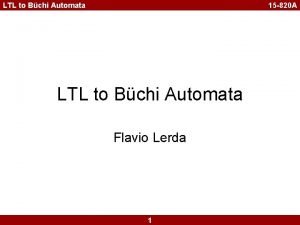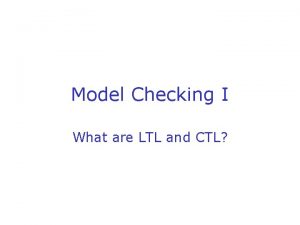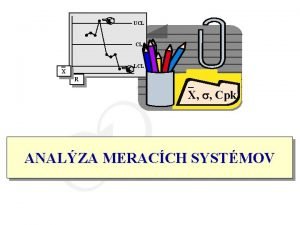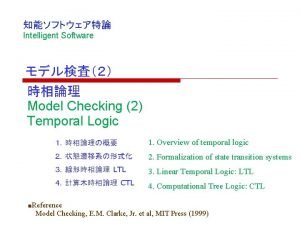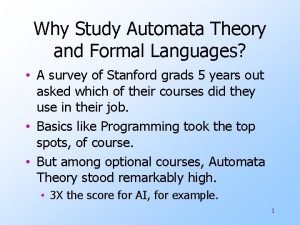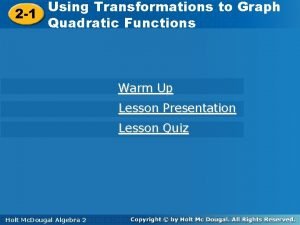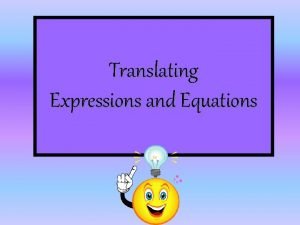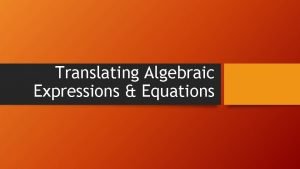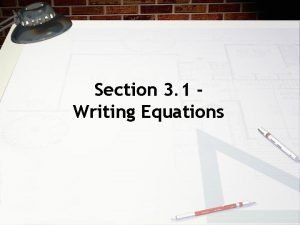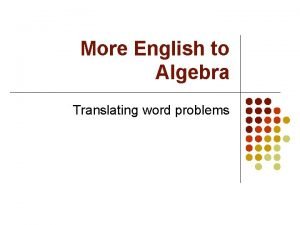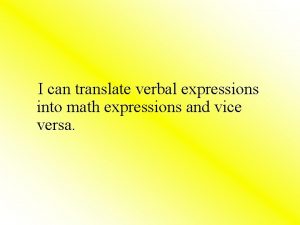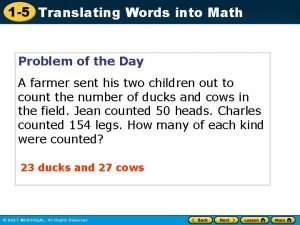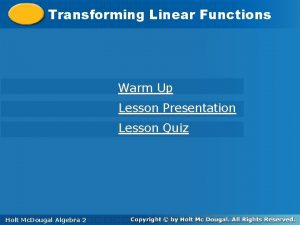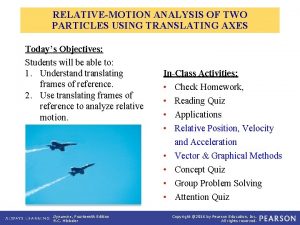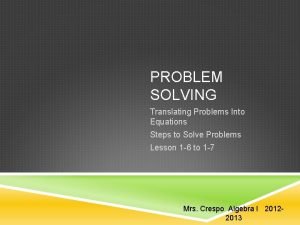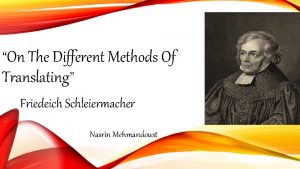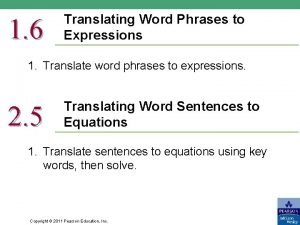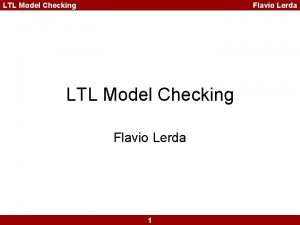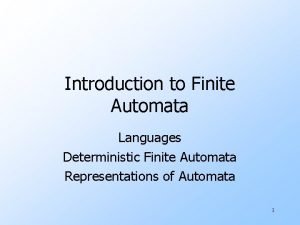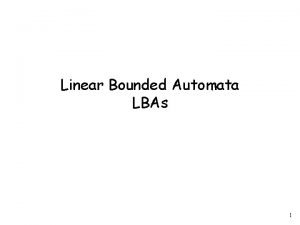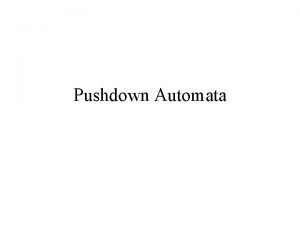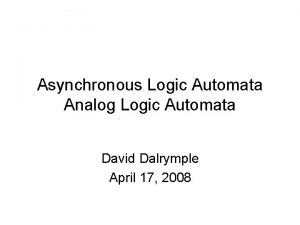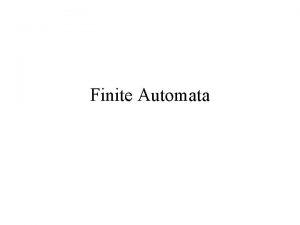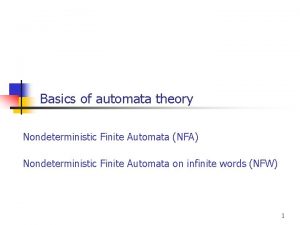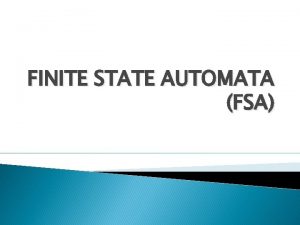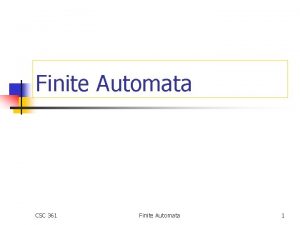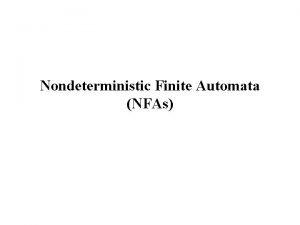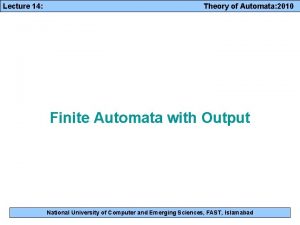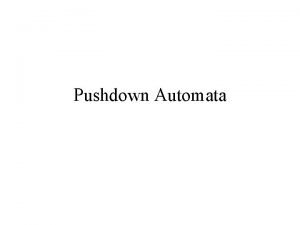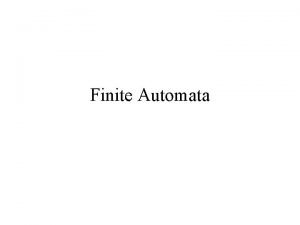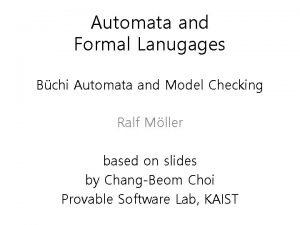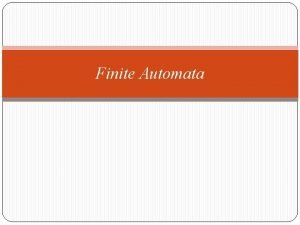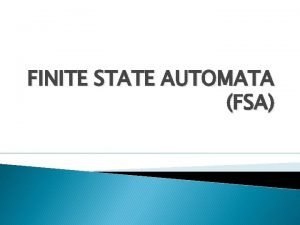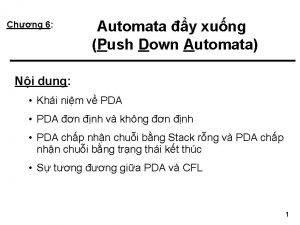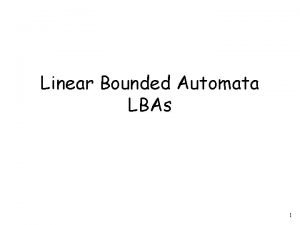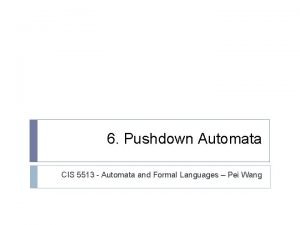Translating from LTL to automata 1 Why translating



























- Slides: 27

Translating from LTL to automata 1

Why translating? n n n Want to write the specification in some logic. Want to check that an automaton (or a Kripke structure) satisfies this property. The check (“model-checking”) will be based on automata operations – hence we need to translate the property to automata. 2

From formulas to Buchi automta Gp p Fp p. Uq GFp T p q p T T Now try yourself: FGp, a U (b U c), X(p U (q Æ r)) 3

A translation algorithm n n So now we need to show an algorithmic translation from LTL to Buchi It will work in two stages: n n Translate to Generalized Buchi Degeneralization. 4

Preprocessing n n n Convert into normal form, where negation only applies to propositional variables. ¬G becomes F¬. ¬F becomes G¬. ¬( U ) becomes (¬ ) R (¬ ), ¬( R ) becomes (¬ ) U (¬ ). 5

Preprocessing n Convert to Negation Normal Form n n Push negations over propositional conenctives, and eliminate operators other than Æ, Ç Eliminate G n Replace G by (False R ). n (in general we can stay with U, R, X) 6

Example n Translate (GF P ) ! ( GF Q ) n n n Eliminate implication ¬( GF P ) Ç ( GF Q ) Eliminate G, F : ¬( False R ( True U P ) ) Ç ( False R ( True U Q ) ) Push negation inwards: (True U (False R ¬P ) ) Ç ( False R ( True U Q ) ) 7

And now. . . n We need to build an automaton that accepts exactly those words that satisfy . 8

Content The construction continues as follows: n 1. 2. 3. Build the Local Automaton n This automaton guarantees that the word satisfies all conditions imposed by the formula Build the Eventuality Automaton n Eventualities : formulas of the form Fφ and φ1 U φ2 n The problem is that nothing prevents us from postponing forever the time at which (eventuality) formula will be true Compose them 9

The Local Automaton n n Closure of : all the subformulas of and their negations. Formally: cl( ) is the smallest set of formulas satisfying the following conditions n n n n φ ∈ cl(φ) φ1 ∈ cl(φ) ⇒ φ1 ∧ φ2∈ cl(φ) φ1 ∨ φ2 ∈ cl(φ) ¬φ1 ∈ cl(φ) ⇒ φ1 , φ2 ∈ cl(φ) X φ1 ∈ cl(φ) ⇒ F φ1 ∈ cl(φ) ⇒ φ1 U φ2 ∈ cl(φ) φ1 R φ2 ∈ cl(φ) φ1 ∈ cl(φ) ⇒ φ1 , φ2 ∈ cl(φ) 10

The Local Automaton / Alphabet, states n The local automaton is L = (∑, SL, ρL, IL, FL) n The alphabet ∑ n n n ∑ µ 2 cl(φ) ∑ elements are consistent: for s 2 ∑ and f ∈ cl(φ): f ∈ s ¬f ∉ s The states SL n All propositionally consistent subsets s of cl(φ): n φ1 ∈ s ¬φ1 ∉ s 11

The Local Automaton / Transition relation The edges: n ρL(s, a) must check the next state is compatible with the semantics of the temporal operators. n n Let t ∈ ρL(s, a). Then: Xφ1 ∈ s φ1 ∈ t n Fφ1 ∈ s or Fφ1 ∈ t n φ1 U φ2 ∈ s (φ2 ∈ s) or (φ1 ∈ s and φ1 U φ2 ∈ t) n φ1 R φ2 ∈ s (φ1 ⋀ φ2 ∈ s) or (φ2 ∈ s and φ1 R φ2 ∈ t) The labeling on the edges: n For a state s ; , s is the label on all the outgoing edges from s. 12

The Local Automaton / Initial + final states n The initial states IL n n . . . is the set of states that include the formula The accepting states FL n . . . is the set of all states 13

Example: Local Automaton for Fp n Closure of Fp n n cl(Fp) = {Fp, p, ¬Fp, ¬p} SL= {{Fp, p}, {¬Fp, p}, {Fp, ¬p}, {¬Fp, ¬p}} 14

Local Automaton for Fp {Fp, p} {Fp, ¬p} {¬Fp, ¬p} Recall the defnition: (Fp ∈ s) (p ∈ s or Fp ∈ t) (t is the target state) Top-right: Since p s then t can only be such that Fp 2 t. Top left: Since p 2 s then all states can be t. Bottom left: contradictory, hence no point in this state (can be removed) Bottom right: since the condition above is iff relation, then we need that (: p 2 s) and (: Fp 2 t). 15

Local Automaton for Fp (labels) {Fp, p} {Fp, ¬p} {Fp, p} {¬Fp, p} {Fp, ¬p} {¬Fp, ¬p} Recall: the edge labels are equivalent to the source state names. 16

The Eventuality Automaton n Eventuality automaton is supposed to check that the eventualities are realized n Check formulas of the form n φ1 U φ2 n Fφ // special case of U 17

The Eventuality Automaton/ Alphabet, states n Ev = (∑, 2 ev(φ), ρF, {{}}, F) n The alphabet n n n ∑ µ 2 cl(φ) ∑ elements are consistent: for s 2 ∑ and f ∈ cl(φ): f ∈ s ¬f ∉ s The states 2 ev(φ) n n The set of subsets of the eventualities of the formula φ A state {e 1, …, ek} means that the eventualities e 1, …, ek still have to be realized 18

The Eventuality Automaton/ Transition relation, initial state n The transition ρF n n Let t ∈ ρF(s, a) n For Fφ : Fφ ∈ t φ ∉ a n For φ1 U φ2 : φ1 U φ2 ∈ t φ2 ∉ a The initial state : {} 19

The Eventuality Automaton/ accepting states n The acceptance condition F is complicated. . . n When can we accept a state s? n n if s has an eventuality, it satisfies it. Examples: n s is accepting: s = {p. Uq, : p, q} s = {: p. Uq, : p, : q} n s is not accepting: s = {p. Uq, p, : q} s = {p. Uq, : p, : q} 20

The Eventuality Automaton/ accepting states n The acceptance condition, formaly: n n n Let ei be an eventuality condition i’ U i Suppose we have the eventuality conditions e 1, . . . , em. Then F is a generalized Buchi condition: F = {Á1, . . . , Ám} where Ái = {s 2 S | ei 2 s ! i 2 s} n In our example: n n We have two states: {} and {Fp} Thus, F contains the single state {} 21

Example Eventuality automaton {Fp, p} {¬Fp, ¬p} {¬Fp, p} {Fp, ¬p} {Fp} {} {¬Fp, ¬p} {¬Fp, p} {Fp, p} We can begin with all edges and all labels and then remove those that are incompatible with the condition we saw in the previous slide: The condition is: Fp ∈ t p ∉ a Q: When is this automaton satisfied? A: When all eventualities are satisfied. 22

Composing the two automata n M = (∑, SM, ρM , NM 0, FM) n ∑ µ 2 cl( ) n SM = SL x 2 ev(φ) n (p, q) ∈ ρM((s, t), a) p ∈ ρL(s, a) and q ∈ ρF(t, a) n NM 0 = Nφ x {} n FM = NL x {} (Cartesian Product) 23

Example Composing the two automata The propositions are the ‘real’ labels. ({¬Fp, ¬p} , Fp) ({Fp, p}, Fp) p : p ({Fp, p}, {}) p : p ({Fp, ¬p} , {}) ({¬Fp, ¬p} , {}) : p 24

Example Composing the two automata Equivalently: labels move to outgoing edges. p ({Fp, ¬p} , Fp) : p ({Fp, p}, Fp) p p ({Fp, p}, {}) p : p ({Fp, ¬p} , {}) : p ({¬Fp, ¬p} , {}) : p 25

Optimizations. . . There are optimizations that make the automaton much smaller: p p p : p If we define the alphabet ∑ as formulas over AP we can do better: true : p p Ç : p p 26

Conclusion n The number of States n Local Automaton : 2 cl(φ) = O(22|φ|) Eventuality Automaton : 2 ev(φ) = O(2|φ|) Composed Automata : 2 cl(φ) X 2 ev(φ) = O(23|φ|) n |φ| is length of formula φ n n 27
 Ltl to buchi automata
Ltl to buchi automata Hey bye bye
Hey bye bye Ltl blanket pricing
Ltl blanket pricing Gg2drop
Gg2drop Zed rtabmap
Zed rtabmap Climate controlled ltl
Climate controlled ltl Process capability ratio
Process capability ratio Utl ltl
Utl ltl Ltl 意味
Ltl 意味 Logistique mode
Logistique mode Automata theory stanford
Automata theory stanford Don't ask why why why
Don't ask why why why Graph using transformations
Graph using transformations Translating strategy into action
Translating strategy into action Translating expressions and equations
Translating expressions and equations Translating linear inequalities
Translating linear inequalities Translate algebraic expressions
Translate algebraic expressions Translating a sentence into a one step equation
Translating a sentence into a one step equation Two less than a number
Two less than a number Clamshell doors reverse thrust
Clamshell doors reverse thrust 1/8 y as a verbal expression
1/8 y as a verbal expression Transformation graphs worksheet
Transformation graphs worksheet 1-5 translating sentences into equations
1-5 translating sentences into equations Transforming linear functions lesson 6-4
Transforming linear functions lesson 6-4 Relative motion of two particles using translating axes
Relative motion of two particles using translating axes How to turn word problems into equations
How to turn word problems into equations Schleiermacher on the different methods of translating
Schleiermacher on the different methods of translating Translate x + 32 a verbal phrase
Translate x + 32 a verbal phrase
